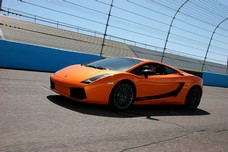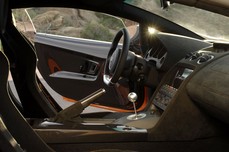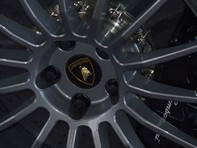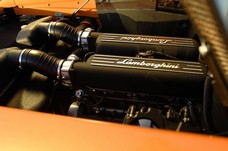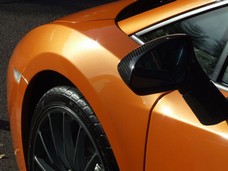Lamborghini Gallardo Superleggera
The Raging Bull sharpens its horns. Andy Enright waves the red rag.
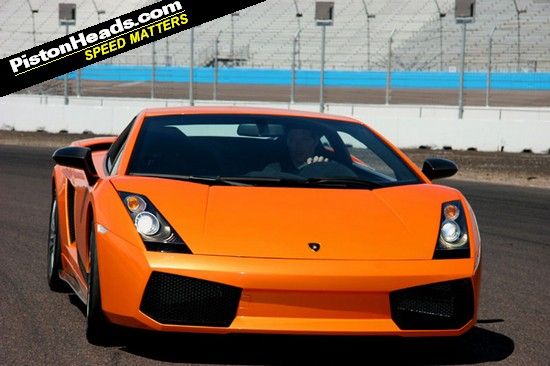
The Gallardo Superleggera
Turn six at Phoenix International Raceway seems innocuous enough. It’s a long, opening hairpin right with a scabby section of grooved tarmac bang on the apex but the Lamborghini Gallardo Superleggera and this corner don’t get along. Every lap sees the lightweight Gallardo introduce another part of its handling repertoire on this same stretch of blacktop. Mild understeer, four-wheel drift, spiky jabs of oversteer – if you didn’t like what it did last time round, have another go and it’ll likely do something different. Chassis engineers would describe the cause of these symptoms as a ‘mid corner yaw gain moment.’
The Superleggera never promised to be wholly benign, despite the apparent safety net of all-wheel drive and a standard switchable ESP stability control package. The key component in the car’s edginess on poor surfaces is the rubber it’s connected to the road with. The Pirelli P-Zero Corsa is a far more aggressive tyre than the regular P-Zero fitted to the standard Gallardo and the increased sidewall stiffness of the Corsa does more than the subtle upgrade to the shock absorbers to change the car’s handling attitude. When surface grip levels suddenly reduce, the Corsas can let go with an abrupt twang rather than a buttery slide, although they’re excellent – and eerily quiet - on decent tarmac where they generate almost nauseating levels of lateral grip.
Many would maintain that a Lamborghini should demand a modicum of respect and the Gallardo has, in the eyes of some unreconstructed old-schoolers, seen Sant’Agata develop a car that’s almost too accessible. The figures indeed bear testament to its broad appeal. In its first two years on sale, the Gallardo shifted more units than the Diablo did in a decade. As a result, 2006 has been the most profitable year in Lamborghini’s history and 2007 will be better. The full 350 car first year production run of Superleggeras has already sold out with orders now stacking up into 2008/09.
Lighter and meaner
It’s easy to dismiss this car as a piece of expensive
one-upmanship and the figures are intriguing. The price premium that Lamborghini charges over the standard Gallardo is a bigger differential than between, say, a 911 Carrera2 S and a GT3 RS. Where Porsche shaves 45kg off the weight of the mainstream car, Lamborghini excises a massive 100kg from the Gallardo’s dry weight, although the 1,330kg Superleggera can’t boast the same step up in comparative power. Standard power to weight ratios aren’t easy to directly compare thanks to Lamborghini’s rather disingenuous quotation of dry weights, the car measured with no liquids whatsoever. Existing Gallardo owners know that their car’s 1,430kg ‘dry’ weight in fact translates to a figure closer to 1,520kg when oiled, watered and juiced up.The excess flab has largely been shorn from the interior, with the replacement of the standard Gallardo seats for beautiful monocoque carbon fibre sports seats being the key change. In the mid-nineties, Lamborghini’s then-owners, the Suhartos, invested heavily in carbon-fibre autoclaves at the factory and since then Sant’Agata has become a centre of excellence for carbon-fibre fabrication. It’s everywhere on the Gallardo Superleggera, from the engine cover to the sleek door mirrors. The doors, the transmission tunnel, the rear diffuser and the rear wing are also finished in carbon fibre. Don’t worry if
you didn’t like the rather aftermarket look of the high rear wing as it’s a £3,100 option. The standard wing is a subtler item that can be adjusted for varying angles of attack. The 15-spoke Skorpius forged rims use titanium wheel nuts to shave a few grammes off the overall weight. An interior carbon package, carbon ceramic brakes, four-point harnesses and a tubular frame system to mount the harnesses to are also on the options list. Four colours are offered – Midas Yellow, Borealis Orange, Noctis Black and the rather uninspiring Telesto Grey. The redesigned instrument panel with white clocks and busy red lettering isn’t the clearest.In the engine room
The engine’s breathing has been improved, both on inlet and exhaust sides, and the ECU has been gently recalibrated to boost power by 10hp to 522hp at 8,000rpm, lifting the power to weight ratio figure close to 400bhp per tonne, a target figure Ferrari will no doubt have pencilled onto the design objectives for the forthcoming F430 Challenge Stradale. The objective gains are small, with 0.2s knocked off the sprint to 62mph where the Superleggera now trips the clock at just 3.8s. The top speed is unaffected at 195.7mph and the torque figure also remains constant at 510Nm at 4,250rpm. What has changed is the engine note which is now even more gloriously addictive at the upper ranges, the V10 now sounding harder-edged and with the volume turned up a notch or two. The minor downside is a droning harmonic in sixth at motorway cruising speeds absent from the standard Gallardo.
As long as you don’t expect 911-style dialogue, the
steering is virtually beyond reproach, making it easy to place this Lambo accurately. Ride quality is excellent as well, with special praise directed at the Superleggera’s brilliant rebound damping. Stability control interventions are soft and well-judged. Body control is similarly impressive, the rigid Gallardo chassis specialising at feeling ‘underneath you’ at all times, right up to that point when it spectacularly isn’t. There’s not the organic, sinewy feel of an F430 or the subtly telegraphed weight shifts of a GT3 here. Instead the Superleggera feels stiff and foursquare. Tiptoe just beyond the limit and it can feel ragged. Deliberately monster it as you might an Evo IX and it pays back.On the Gallardo, the manual gearbox is a standard fit item, with the e-gear sequential manual box tacking another £7,000 onto the car’s price. With the Superleggera, cars with e-gear and manual boxes are priced identically, so Lamborghini are rather cheekily asking manual owners to subsidise e-gear purchasers. If you are decided on the e-gear system, it narrows the price differential between the two cars markedly.
The e-gear box is quick but still a little rough around the edges, slamming through the gears with some driveline shock when set into sport mode. The change paddles are also a little smaller than would be ideal, with many testers flashing the lights or washing the screen when fumbling for the wand on the exit to a tight corner. It’s got quite a personality when set to full automatic as well, throwing in the odd spectacularly flamboyant throttle blip just to make sure you’re paying attention. Once you’ve mastered the change from second to third, the manual car is virtually beyond reproach. Apart from the nagging suspicion that Lamborghini has chiselled you for £7,000.
Unless you’re going to be subjecting the Superleggera to some pitiless track work, we’d skip the carbon ceramic brake option. This setup weighs no less than the steel discs, stops no quicker and has a worryingly weighty dead spot at the top of the pedal travel that led to several heart-in-mouth moments in the downtown Phoenix traffic.
Verdict
Anything based on a Lamborghini Gallardo is going to be a fantastic thing but the Superleggera package is not without caveats. Standard fit electric windows, air conditioning, ESP and options that include rear view parking cameras, sat nav and multimedia systems do not smack of unyielding focus and despite the weight loss plan, the Gallardo’s power to weight gain isn’t great when gauged against the incremental expense. For some, this will matter little. They will want the most capable car Lamborghini makes and this is undoubtedly it. What it manifestly isn’t is the true featherweight that many of us had hoped for; the car with a roll cage, shorn of the luxuries, with a 25:75 rear-drive bias and packing another 75bhp amidships.
As it stands, the Gallardo Superleggera is a tough car to preside over. While aspects of it send mixed messages, it still contrives to be the best car in its class by some margin. A beautiful artifice it may be, but it’s nevertheless jaw-slackeningly desirable. Especially in Borealis Orange.
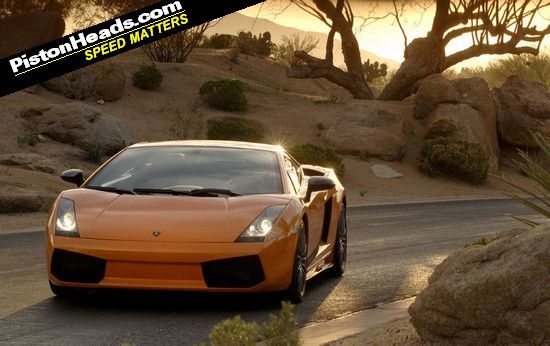
"jaw-slackeningly desirable"
Despite campaigning a RWD racing Murcielago, Lamborghini are very firm about the company's commitment to four-wheel drive super sports cars, seeing it as a crucial differentiating point versus Ferrari. Rumour has it that a rear-wheel drive Gallardo has been tried and rejected.
The Superleggera in standard trim is probably a better road and track car than the standard Gallardo but it's a lot of money for a modest increase in ability. It's possible to option it up to the nines and easily fork out over £160k on one (and many will) but it'll never be as hardcore as many of us wanted. For a company that proclaims its extremity as stridently as Lamborghini, this strikes me as a shame. It's also worth remembering that the weight loss for US customers is 70kg rather than 106kg due to the fact that Lambo would have to regain type approval for the car if they were to ditch the seats with side airbags.
Unless spotting a Superleggera is really going to ruin your day, I'd stick with your current car. It's just beautiful.
its also rather foolish of them to admit the stopping distances are the same!
so all in all whats the point!
BTW what does the interior carbon fibre option consist of, if the interior is mostly carbon fibre anyway?
I agree with your comments re: the brakes. The discs will weigh less than half a cast iron disc, so weight savings are unavoidable in this area.
The interior saves weight by adopting Alcantara instead of leather, door cards are carbon and the seats weigh very little compared to stock. The carbon pack (which is standard in the Superleggera, but optional on the stock car) won't save any weight atall. The entertainment system is also optional, either nothing or SatNav. The crappy tape player based system has been junked.
its also rather foolish of them to admit the stopping distances are the same!
so all in all whats the point!
BTW what does the interior carbon fibre option consist of, if the interior is mostly carbon fibre anyway?
My Gallardo has standard brakes and I've driven Gallardo cars with the CCB
There is just no way the stopping distance is the same, the CC brakes are far better
Although I hate to admit it, the CC brakes in my 430 are also much better than the Lambo CC brakes
666. Cool! Ofcourse, this has now been ruined by this post. Dammit!

Doug. Interesting comment, mate. As Brembo supply the brakes to both manufacturers we can only assume the difference in performance is down to the extra inertia of the front wheel transmission. Either that or there's some difference in servo/master cylinder setup.


The only advantage therefore will be the ability of the carbon brakes to withstand more applications without overheating and fading.
There may be some advantage in the carbon brakes being lighter and so enabling the (reduced) unsprung and rotating mass to be slowed quicker, but in this instance they claim that the larger carbon brakes remove any weight advantage.
Despite campaigning a RWD racing Murcielago, Lamborghini are very firm about the company's commitment to four-wheel drive super sports cars, seeing it as a crucial differentiating point versus Ferrari. Rumour has it that a rear-wheel drive Gallardo has been tried and rejected.
The Superleggera in standard trim is probably a better road and track car than the standard Gallardo but it's a lot of money for a modest increase in ability. It's possible to option it up to the nines and easily fork out over £160k on one (and many will) but it'll never be as hardcore as many of us wanted. For a company that proclaims its extremity as stridently as Lamborghini, this strikes me as a shame. It's also worth remembering that the weight loss for US customers is 70kg rather than 106kg due to the fact that Lambo would have to regain type approval for the car if they were to ditch the seats with side airbags.
Unless spotting a Superleggera is really going to ruin your day, I'd stick with your current car. It's just beautiful.
thanks for the detailed response. i tend to agree that it's not worth the difference in performance. when fully optioned up (the larger tail is $5k+ and the seats--which you have to buy separately in the U.S.--are $7.5k), it is north of $260k. suddenly, you are in F430 Challange (dedicated track car) territory. my guess on the 2wheel drive issue is that Lambo realized that the handling with so much HP on 2wheels would not be great without some sort of "manettino-type" system that exists on the Ferrari (both for insurance and feature comparison reasons). so the cheapest, fastest, safest way to go was to stick with 4wheel drive. that's too bad. i also hoped that they would have finally gotten rid of the Audi parts-bin interior pieces in the center console for '08, but i suppose that's a way off still.
thanks again for the review!
Gassing Station | Supercar General | Top of Page | What's New | My Stuff

